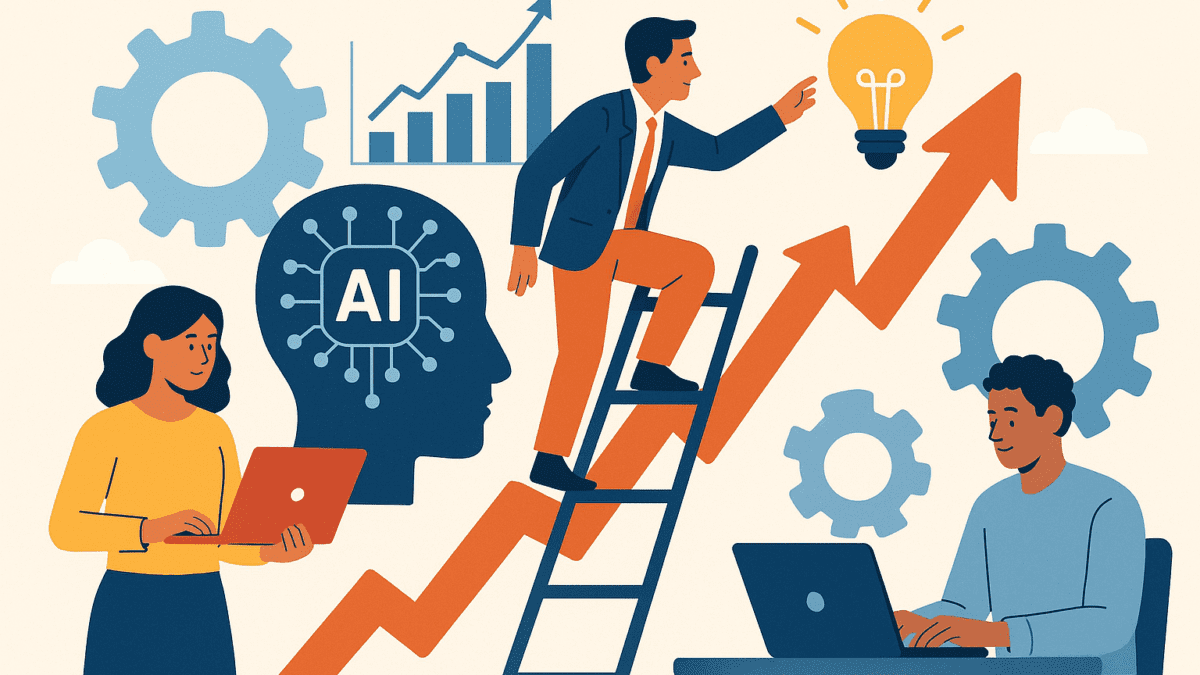Continuous Upskilling: Preparing Workforces for an AI-Dominated Future
Table of Contents
Artificial Intelligence (AI) is reshaping industries at a pace never seen before. From automated marketing campaigns to AI-driven financial forecasting, businesses are adopting intelligent systems to stay competitive.
But as AI evolves, so must the workforce. Traditional training models no longer suffice. The future demands continuous upskilling—equipping employees with the skills needed to adapt, innovate, and thrive in an AI-dominated world.
This article explores why continuous upskilling matters, the key skills for the AI era, and how businesses can build learning cultures to future-proof their teams.
Why Continuous Upskilling Matters in an AI-Driven Economy
AI is moving fast. 44% of workers’ skills will be disrupted by 2027 due to AI and automation, according to the World Economic Forum.
Why this matters for business:
Why this matters for businesses:
- Talent Shortages: Companies without skilled employees risk falling behind.
- Employee Retention: Workers who receive upskilling opportunities are more loyal.
- Innovation: Upskilled employees can leverage AI for new solutions.
In short, upskilling is not just about surviving – it’s about thriving in a changing world.
Skills That Define the AI-Ready Workforce
To succeed in the AI era, employees need both technical and human-centric skills.
Key skill categories include:
- AI & Data Literacy – Understanding how AI systems work, analyzing data, and interpreting results.
- Digital Skills – Cloud computing, cybersecurity, and software adoption.
- Critical Thinking – Evaluating AI-generated outputs for accuracy and fairness.
- Adaptability & Agility – Learning new tools quickly and shifting roles as needed.
- Emotional Intelligence – Managing collaboration between humans and AI.
Example: A marketing professional may not code AI tools but must know how to use AI-driven analytics to design smarter campaigns.
Step-by-Step Guide to Building a Continuous Upskilling Culture
- Assess Skills Gaps – Use surveys, performance data, and AI tools to identify weak areas.
- Set Learning Goals – Align upskilling programs with company strategy.
- Leverage AI-Based Learning Platforms – Personalized learning paths ensure employees train at their own pace.
- Encourage Microlearning – Short, focused modules fit into daily workflows.
- Create Incentives – Reward certifications and learning milestones.
- Measure Impact – Track KPIs like productivity, retention, and innovation output.
This structured approach ensures upskilling becomes an ongoing cycle, not a one-time initiative.
Real-World Examples of Upskilling in Action
- Amazon: Invested $700 million in reskilling programs, training over 100,000 employees for technical roles.
- PwC: Launched a “Digital Fitness” app, allowing employees to self-assess and improve digital skills.
- AT&T: Created its “Future Ready” program, retraining staff in data science and cybersecurity.
These initiatives prove that continuous upskilling not only improves workforce readiness but also drives competitive advantage.
The Role of AI in Upskilling
Interestingly, AI is not just reshaping jobs—it’s also powering the upskilling process.
AI-enabled upskilling tools can:
- Personalize training based on employee performance
- Predict future skills needed for roles
- Automate learning recommendations
- Provide real-time feedback and coaching
Example: AI-driven learning management systems (LMS) can suggest new skills to employees as their job roles evolve, ensuring they remain relevant.
Challenges Businesses Face in Upskilling
While continuous upskilling is essential, it comes with challenges:
- Budget Constraints: Training requires investment.
- Time Management: Employees struggle to balance learning with daily tasks.
- Resistance to Change: Some workers fear AI will replace them, reducing motivation.
- Skill Relevance: Rapid AI innovation means skills can become outdated quickly.
To overcome these challenges, companies must foster a growth mindset culture and make learning accessible, rewarding, and future-focused.
Best Practices for Successful Upskilling Programs
To ensure long-term success, businesses should:
- Start small with pilot programs before scaling.
- Offer blended learning (online + in-person).
- Partner with universities and training providers for certifications.
- Align learning outcomes with business KPIs.
- Promote peer-to-peer learning to encourage collaboration.
The Future of Work: Human + AI Collaboration
The workforce of the future won’t be humans vs. AI—it will be humans working with AI.
Employees who continuously upskill will:
- Use AI to handle repetitive tasks
- Focus on creative problem-solving and strategy
- Drive innovation in ways machines cannot
Companies that embrace this mindset will not only survive but thrive in an AI-dominated world.
Conclusion
Continuous upskilling is no longer optional—it’s a business necessity. Organizations that prioritize learning will build resilient, innovative, and future-ready workforces.
By combining AI technology with human adaptability, businesses can prepare employees not just to keep up—but to lead in the age of AI.
Ready to prepare your workforce for the future? Explore ourEmail Marketing Services and learn how AI-driven solutions can support your upskilling journey today.





